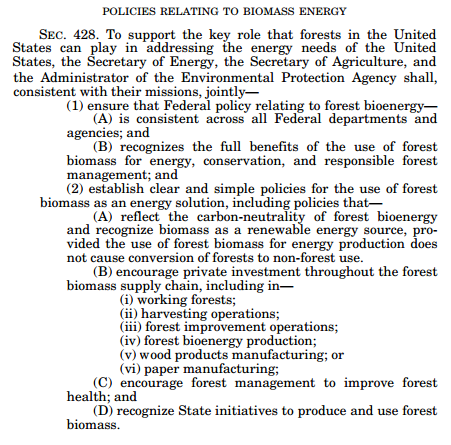
One small section of a 798-page bill titled the “Consolidated Appropriations Act, 2017” was clearly written by lobbyists for the forest products industry. Buried on page 366 is this statement:
To support the key role that forests in the United States can play in addressing the energy needs of the United States, the Secretary of Energy, the Secretary of Agriculture, and the Administrator of the Environmental Protection Agency shall, consistent with their missions, jointly establish clear and simple policies for the use of forest biomass as an energy solution, including policies that reflect the carbon-neutrality of forest bioenergy and recognize biomass as a renewable energy source, provided the use of forest biomass for energy production does not cause conversion of forests to non-forest use.

In a piece for ClimateCentral.org titled “Spending Deal Overrides Climate Science on Wood Energy“, John Upton explains that this change is intended to put the burning of wood (“biomass”) on the same footing as clean renewable energy sources like solar and wind:
Congress’s bipartisan spending agreement could fund federal government operations for less than a year, but its effects on climate policy could persist through future presidential administrations.
[The] appropriations bill directs several federal agencies to develop consistent policies that would, in many circumstances, define wood energy as being as friendly for the climate as solar or wind power, despite its heavy climate impacts.
While burning wood for energy can help with the disposal of waste and reduce fossil fuel use, it releases more heat-trapping carbon dioxide than heavily polluting coal.
Warren Cornwall at Science goes further, explaining that the move goes against the beliefs of the scientific community and suggesting that policy matters like this should be the scientific community who decides what is and what isn’t “carbon neutral”:
[C]ritics charge the carbon math for these power plants is far more complicated, and that the amendment seeks to replace scientific judgment with a political declaration. “The Senate is on the verge of mandating that it’s carbon neutral, and it isn’t,” says Philip Duffy, president and executive director of the Woods Hole center, a nonprofit climate research group in Falmouth, Massachusetts. He helped write the letter and recruited scientists with backgrounds in climate, energy, and forest ecology to sign it. “It should be the scientific community and the engineering community, and not the Senate or another legislative community, saying what’s carbon neutral.”
The letter notes that burning wood releases more carbon dioxide than coal for each unit of power produced. And there’s no assurance all that carbon will wind up back in trees and the ground, the scientists caution. Logged land could be put to other uses, new forests might be managed differently than the ones they replaced, and insect infestations or droughts could make it hard to reestablish trees.
After Upton’s piece came out, Andrew Johnson, vice president of TSI, manufacturer of process equipment used in the engineered wood and biomass industries, wrote a rebuttal. His argument is that carbon locked up in wood will be released into the atmosphere when the wood eventually rots – which is true – which makes the burning of wood carbon neutral. Trees take carbon from the atmosphere to build structure (wood, bark, and leaves), all of which is returned to the atmosphere when it decomposes or is burned.
However, what Johnson doesn’t address is the way in which this happens. As Upton points out in a piece at Grist, while it’s true that decomposing wood does release carbon, it does so near the earth’s surface where it is quickly taken up by plants and trees. On the other hand, both burning coal and wood “shift carbon from near the Earth’s surface into the atmosphere, where it traps heat, while doing little to directly promote forest growth.”
Perhaps the biggest problem, however, is that government policies like these encourage countries to exploit wood as an energy source rather than investing in clean, renewable energy sources that go beyond carbon neutrality and actually release no carbon at all. With the burgeoning carbon pellet industry, which depends on the burning of wood to generate heat and electricity, this is already happening, particularly in Europe.
This new law used appropriations legislation to enact energy policy and it’s gone largely under the radar. But, as I said at the beginning, it seems quite evident that this part of the bill was written by forest product industry lobbyists and not scientists because the forest product industry stands to reap huge profits as the pellet industry continues to grow. And it’s that industry that will stand to gain the most if their customers are able to claim burning their pellets is “carbon neutral”. This is particularly true if, like in parts of Europe, this sort of policy leads to big tax breaks and other incentives to promote the use of “bioenergy” like the burning of wood.
At the end of the day, it’s a backhanded way of “picking winners and losers” and delivering profits to a specific industry, something Republicans only hate when it’s done by Democrats.
[CC photo by Scott Smithson | Flickr]



